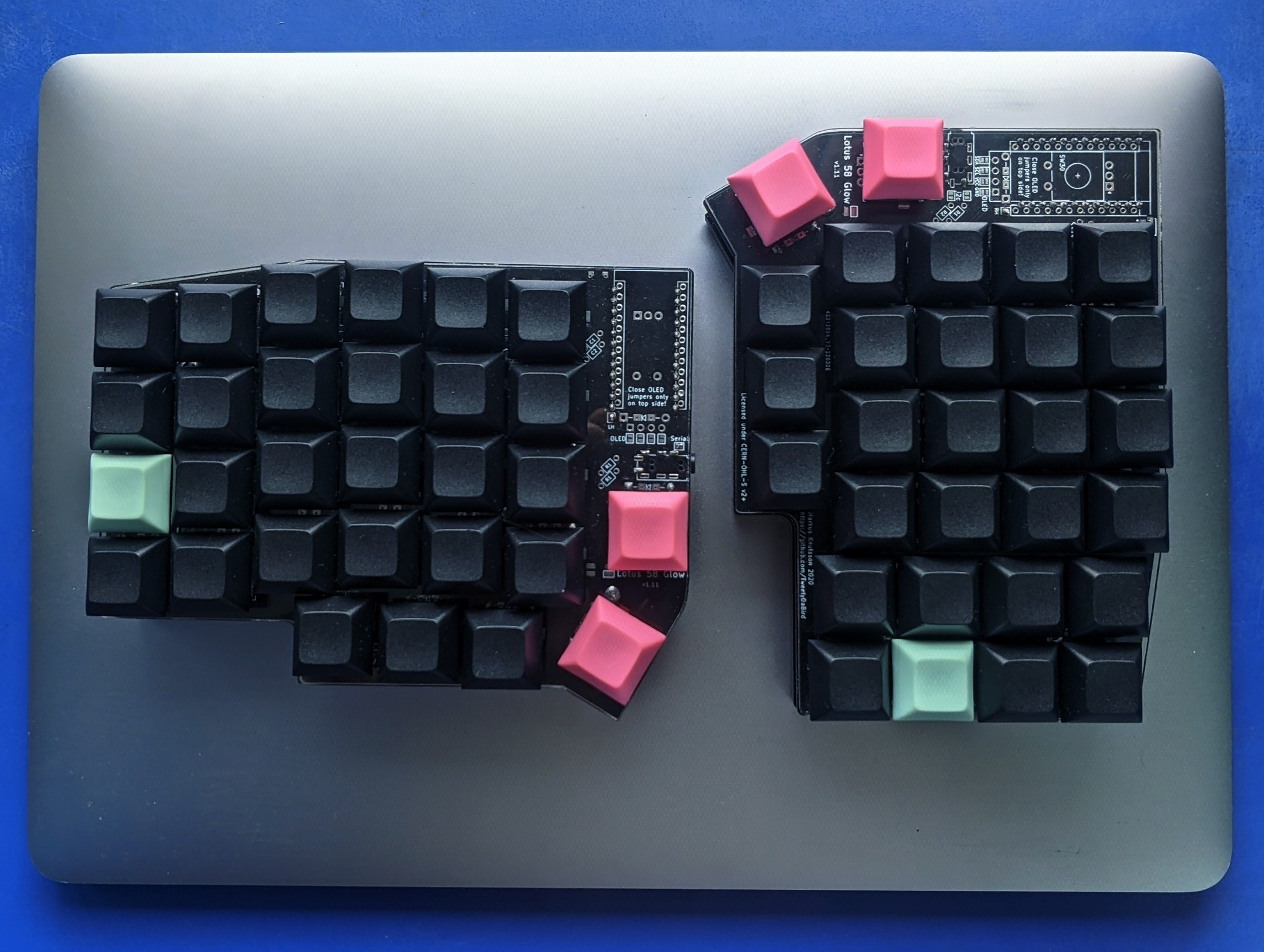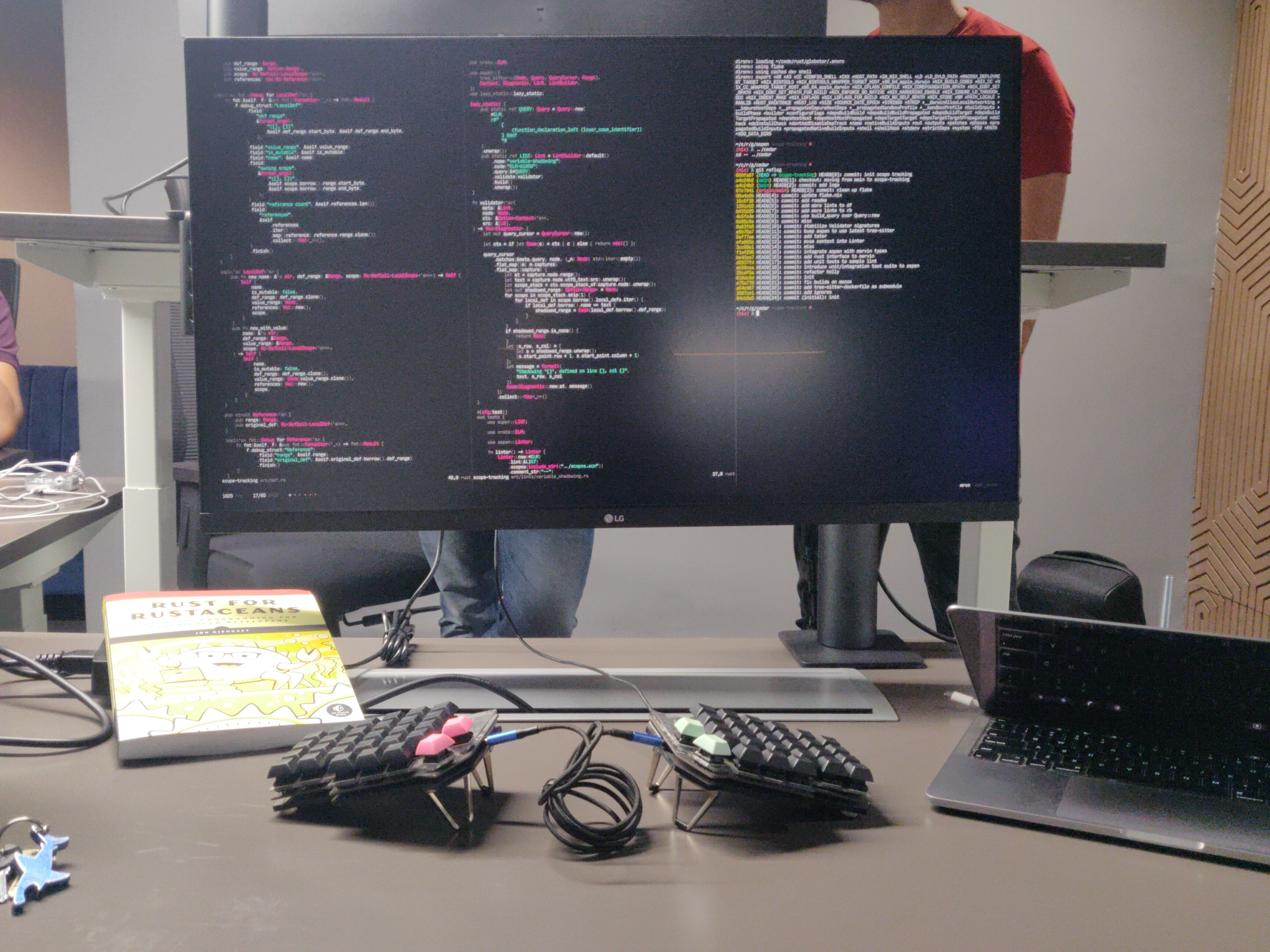diff options
Diffstat (limited to 'posts/lotus58.md')
| -rw-r--r-- | posts/lotus58.md | 135 |
1 files changed, 135 insertions, 0 deletions
diff --git a/posts/lotus58.md b/posts/lotus58.md new file mode 100644 index 0000000..2a83872 --- /dev/null +++ b/posts/lotus58.md | |||
| @@ -0,0 +1,135 @@ | |||
| 1 | Earlier this month, I decided that I would laugh at Indian | ||
| 2 | customs in the face by building a split-ergo mechanical | ||
| 3 | keyboard from scratch rather than purchasing a Moonlander. | ||
| 4 | |||
| 5 |  | ||
| 6 | |||
| 7 | ## Sourcing the parts | ||
| 8 | |||
| 9 | If you, like me, live in India, you might find this section | ||
| 10 | useful. My approach to finding parts: | ||
| 11 | |||
| 12 | - Check reputed, local online stores | ||
| 13 | - Check physical hardware stores | ||
| 14 | - Import the part | ||
| 15 | |||
| 16 | ### PCBs | ||
| 17 | |||
| 18 | This was by far the hardest component to procure. | ||
| 19 | Fabrication services have certain _capabilities_. | ||
| 20 | Capabilities are the limitations of a fabrication service. | ||
| 21 | For example, a service may be capable of drilling holes no | ||
| 22 | smaller than 0.3mm in diameter. Most sites have a | ||
| 23 | verification process to check if their capabilities meet | ||
| 24 | your design's requirements. I tried a few local PCB | ||
| 25 | fabrication services: | ||
| 26 | |||
| 27 | - Lion PCB: Capabilities did not meet my requirements | ||
| 28 | - PCBPower: Capabilities did not meet my requirements | ||
| 29 | - Circuitwala: Capabilities did not meet my requirements | ||
| 30 | |||
| 31 | I settled for JLCPCB, a Chinese service. PCBs themselves | ||
| 32 | were 16 USD, shipping was another 35 USD, and customs was | ||
| 33 | another 3.5K INR (ouch). | ||
| 34 | |||
| 35 | |||
| 36 | ### Case material | ||
| 37 | |||
| 38 | I don't really have a case for the Lotus58, it is more of a | ||
| 39 | "plastic sandwich". I purchased acrylic plates from Robu. | ||
| 40 | Cheap, fast, solid, and customizable. I cannot recommend | ||
| 41 | Robu enough. A full set of plates (2 top plates and 2 bottom | ||
| 42 | plates) cost me about 500 INR. I also bought a pair of | ||
| 43 | laptop height raisers on Amazon to create a budget tenting | ||
| 44 | setup. | ||
| 45 | |||
| 46 | ### Electronics | ||
| 47 | |||
| 48 | You'll need a few rather specific electronic components such | ||
| 49 | as hotswap sockets and TRRS mounts, the rest are commonly | ||
| 50 | available: | ||
| 51 | |||
| 52 | - Hotswap sockets: StacksKB | ||
| 53 | - TRRS mounts (PJ 320A): StacksKB | ||
| 54 | - Diodes (1N4841): StacksKB | ||
| 55 | - M2 screws: StacksKB | ||
| 56 | - M2 spacers: ThinkRobotics | ||
| 57 | - Arduino Pro Micro: Robu | ||
| 58 | |||
| 59 | I skimped out on optional components such as OLEDs and | ||
| 60 | rotary encoders. | ||
| 61 | |||
| 62 | ### Switches and Keycaps | ||
| 63 | |||
| 64 | Arguably the most fun part of the build: | ||
| 65 | |||
| 66 | - Gateron Oil King switches: Rectangles | ||
| 67 | - DSA blanks: Meckeys | ||
| 68 | |||
| 69 | ## Building the keyboard | ||
| 70 | |||
| 71 | The the build is extremely straightforward. Through hole | ||
| 72 | components are easy to solder. Be wary of component | ||
| 73 | placement and orientation. Check thrice, solder once. Few | ||
| 74 | debugging tips: | ||
| 75 | |||
| 76 | - if a single key does not actuate, check the hotswap for | ||
| 77 | poor soldering (reflow the joint), and the switch pins for | ||
| 78 | deformation during installation | ||
| 79 | - if an entire column or row activates on a single | ||
| 80 | key-press, a connection has been shorted | ||
| 81 | - if only some of the keys on a given row actuate, a diode | ||
| 82 | has been soldered on the wrong way | ||
| 83 | |||
| 84 | ## The typing experience | ||
| 85 | |||
| 86 | I decidede to give QWERTY the boot and learn Colemak along | ||
| 87 | with the new keyboard. The first few weeks were terrible | ||
| 88 | because I could neither type QWERTY nor Colemak, but I got | ||
| 89 | the hang of it pretty quickly. Typing websites do help, but | ||
| 90 | it is best to simply use it in your daily workflow. No site | ||
| 91 | can help you get accustomed to the various things you use | ||
| 92 | your keyboard for such as switching windows or navigating | ||
| 93 | vim/tmux. | ||
| 94 | |||
| 95 | ### Colemak | ||
| 96 | |||
| 97 | Alt layouts such as Colemak are definitely worth it. I find | ||
| 98 | that Colemak reduces finger movement a lot, a good portion | ||
| 99 | of the keys on the left hand are the same as QWERTY, it | ||
| 100 | is fairly easy to pick up as well. | ||
| 101 | |||
| 102 | ### Vim | ||
| 103 | |||
| 104 | Using an alt layout means most programs with keyboard | ||
| 105 | shortcuts are not going to work as expected, `HJKL` on vim for | ||
| 106 | movements being one of them. I took the short route out by | ||
| 107 | creating a new layer with arrow keys on the home row: | ||
| 108 | |||
| 109 | ``` | ||
| 110 | default homerow: | ||
| 111 | H N E I | ||
| 112 | |||
| 113 | "nav" layer: | ||
| 114 | < v ^ > | ||
| 115 | ``` | ||
| 116 | |||
| 117 | The remaining commands in vim are largely mnemonics. | ||
| 118 | Navigating with home-row arrow keys also means that I can | ||
| 119 | use "HJKL" globally, to scroll a website, for example. | ||
| 120 | |||
| 121 | ### Cutting down to 34 keys | ||
| 122 | |||
| 123 | A couple months into my ergo journey, I realized that I | ||
| 124 | could get away by moving my fingers even lesser. I moved | ||
| 125 | modifiers such as `Super`, `Ctrl`, `Alt` and `Shift` to the | ||
| 126 | home-row as QMK Mod Taps. The rest of the keys are cleverly | ||
| 127 | placed in layers, not too much unlike the Miryoku layout. | ||
| 128 | Even for someone that writes Rust (a symbol-heavy grammar), | ||
| 129 | I find 34-keys to be sufficient. | ||
| 130 | |||
| 131 | ## Conclusion | ||
| 132 | |||
| 133 | I have been bitten by the ergomech bug. | ||
| 134 | |||
| 135 |  | ||
